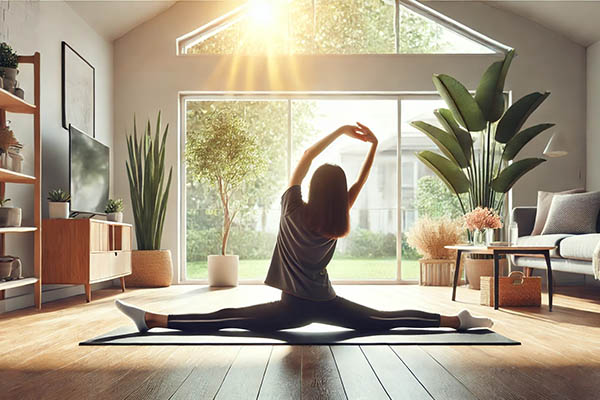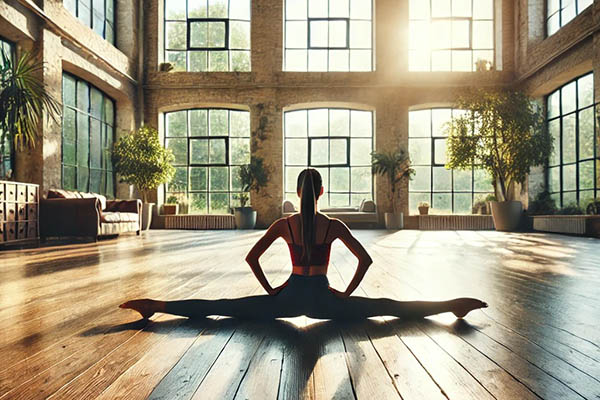You’ve probably seen it — some fitness influencer on TikTok casually drops into a perfect middle split and says, “This will make you taller.” Bold claim, right? The idea’s been floating around for years, picking up steam in forums, YouTube comment threads, and stretch-challenge groups. And to be fair, it’s not entirely off-base — but it’s not the full picture either.
See, there’s a big difference between actual height (what you measure on a stadiometer) and visual height (how tall you look to others). That’s where flexibility, posture, and muscle elongation come into play. This is where things get interesting — because what’s really at stake here isn’t your bones magically stretching overnight, but how your body moves, holds itself, and gives the illusion of extra inches.
In a second, you’ll get into the biomechanics, the science behind stretch training, how growth plates work (especially during adolescence), and whether splits actually influence any of it — or if it’s just another fitness myth.
The Anatomy of a Split: What Happens to Your Body
Doing a full split isn’t just about brute flexibility — it’s a full-body negotiation between muscle groups, joint mobility, and your nervous system deciding whether or not it trusts you not to tear anything. Sounds dramatic, but that’s pretty much what’s going on under the surface.
The muscles doing the heavy lifting (or stretching, really) are:
- Hip flexors – especially the iliopsoas and rectus femoris, which tend to get super tight if you sit a lot (and let’s be real, most people do).
- Hamstrings – particularly the semitendinosus and biceps femoris, which resist lengthening if you’re not actively working on posterior chain mobility.
- Adductors – the inner thigh muscles that often feel like they’re being personally victimized when you’re pushing into middle splits.
- Glutes and calves – not the stars of the show, but they show up as stabilizers whether you want them to or not.
Now, joints don’t actually stretch — they rotate. That’s where hip external rotation and pelvic tilt come into play. If your pelvis can’t rotate forward and your femurs don’t have room in the socket, even the most stretched hamstrings won’t get you to the floor.
Over time, you’ll notice changes in:
- Tendon tension release (think hamstring tendons that no longer snap back like rubber bands)
- Fascia responsiveness – that’s the deep connective web that wraps everything together
- Spinal alignment, especially if your splits are asymmetrical — that twist adds up if left unchecked
Here’s the kicker: stretching for a split won’t lengthen your bones. But it can increase your range of motion, improve posture, and give your body the elongated look of someone who moves with ease and control. That’s the kind of “taller” people actually notice.

Stretching vs. Growing: Misconceptions About Height
It’s one of those ideas that just feels like it should be true — stretch more, and you’ll get taller. Simple, right? Well, not quite. What you’re actually doing during a deep stretch session isn’t growing taller — it’s giving your muscles and spine room to breathe, temporarily.
Here’s the deal: muscles can elongate, sure, but bones? Not after the growth plates close (which usually happens by your early 20s). Stretching gives that loose, lengthened feeling mostly because:
- Spinal decompression helps ease the pressure on your vertebral discs — especially after long hours sitting or standing. That little bit of regained intervertebral space can make you feel lighter, maybe even a half-inch taller… for a few hours.
- Postural lengthening happens when tight hips or a forward-tilted pelvis start to realign. The difference in how you stand can look dramatic — but it’s not bone-deep.
- Elasticity in muscles and fascia improves with consistent stretching, which can boost your vertical reach, but again — it’s mostly functional, not structural.
So yes, stretching makes you feel taller and look more upright, but it’s not actual growth. The illusion works best when posture, spinal health, and flexibility all come together.
Posture and Perception: Why You Might Look Taller
You know that moment when someone walks into a room and just seems taller than you remember? Odds are, it’s not a growth spurt — it’s posture doing the heavy lifting. That upright, open stance sends a visual signal of height, confidence, and control. And yes, splits — as odd as it sounds — can actually help with that.
The deeper flexibility developed through split training releases tension in key areas, especially the hip flexors and hamstrings. When those muscles are tight, they pull your pelvis into an anterior tilt, which throws off your spinal alignment and makes you look shorter and slouchier. Add in weak core muscles and now the whole structure collapses inward — not exactly the tallest version of you.
But here’s what works over time:
- Looser hips = reduced pelvic tilt, allowing your spine to stack more naturally
- Improved core engagement stabilizes your midsection and lifts your upper body
- Increased body awareness changes how you carry yourself — not just on the mat, but walking down the street
So no, splits won’t stretch you into a taller person. But by improving postural alignment and how your body holds itself in space, they can shift how tall you appear. And honestly, that’s what most people notice first.

Role of Splits in Adolescents vs. Adults
Now, this is where the conversation really needs some clarity — because there’s a huge difference between doing splits at 13 and doing them at 30. It’s not just about flexibility or strength — it comes down to whether your growth plates are still open or if epiphyseal closure has already happened.
In adolescents, especially pre- and mid-puberty, the body’s still in a phase of growth potential. The cartilage plates at the ends of long bones (yep, those are the growth plates) haven’t hardened into bone yet. So there’s still space — quite literally — for vertical growth. That said, doing splits doesn’t directly stimulate those plates. What it can do is improve mobility during development, which supports better posture, balance, and movement patterns while the body is still figuring itself out.
For adults, it’s a different story. Once those plates are fused — and they will fuse, typically by the late teens or early twenties — splits won’t change bone length. What they do is enhance muscle elasticity, reduce tightness, and improve how the pelvis and spine align — all of which can make someone look taller, even if the tape measure says otherwise.
And one more thing: a lot of online fitness content aimed at teens casually implies that splits = height gains. That’s not just misleading — it can set up unrealistic expectations and lead to pushing too hard, too soon. Flexibility is great, especially when started young, but pushing into deep splits without proper form or progression? That’s a fast track to strained ligaments, not long legs.
So if you’re still growing, use that time wisely — not to force height through stretching, but to build healthy mobility habits that stick around long after the growth plates call it quits.
Expert Opinions: What Science and Trainers Say
You see, this whole debate about splits making you taller tends to fall apart the moment actual experts weigh in. Sports scientists, physical therapists, and orthopedic specialists all circle back to the same point: flexibility affects how you move, not how tall you become. And the research backs that up pretty consistently.
In exercise science, clinical trials show that stretching can improve functional movement, reduce stiffness, and enhance mobility protocols — but none of those adaptations extend bone length. A leading physiologist once explained it this way: “Flexibility changes muscle behavior, not skeletal dimensions.” That’s the kind of blunt honesty that tends to get lost on TikTok.
Trainers in sports medicine offer a similar angle. Many of them describe stretching as a tool for postural refinement — something that gives your spine a more natural stacking and reduces the compressed look that comes from tight hips or a rounded upper back. But when someone asks whether splits stimulate height? The typical response is that this claim doesn’t match any known biomechanics.
What you’ll find, especially when digging into functional movement analysis, is that stretching helps you stand, move, and carry yourself in ways that project height — not create it. And honestly, that realistic expectation sets you up for far better progress than chasing whatever trend pops up next on social media.
Realistic Benefits of Doing Splits (That Aren’t Height)
Let’s clear the air: doing the splits won’t make you taller — but that doesn’t mean it’s pointless. Far from it. Splits are one of those movements that offer way more than they get credit for. It’s not about aesthetics; it’s about how your body moves and holds itself under tension.
When you commit to regular split training, what you’re really building is a kind of physical intelligence — better mobility, enhanced neuromuscular control, and more resilient connective tissue. Over time, this translates into:
- Improved proprioception — so your body knows where it is in space
- Reduced injury risk, especially in high-torque sports or dynamic training
- More efficient movement patterns, thanks to healthier fascia and joint mobility
- Better circulation, particularly in the hips and legs, which often get neglected in static routines
You’ll also notice subtle shifts in everyday posture. Flexibility in the hip flexors and hamstrings often leads to more upright standing and walking mechanics — which does make you appear longer and more aligned, even if the tape measure says otherwise.
So no, splits don’t equal height gain. But they absolutely pay off — in performance, in injury prevention, and in how confidently you move through your own body. That’s the kind of “gain” that actually sticks.
The Role of Spinal Decompression and Hanging Exercises
If you’re chasing that extra inch, even temporarily, hanging might actually do something — just don’t expect a miracle. What’s really happening during hanging or inversion isn’t bone growth, but axial elongation — basically, using gravity to reverse some of the daily compression your spine goes through.
Throughout the day, your spine compresses under body weight and posture stress. Those soft intervertebral discs lose a bit of fluid, and the total height shrinks slightly — sometimes up to 1–2 cm by nighttime. When you hang from a bar or use an inversion table, you’re allowing the spine to decompress. This vertebral separation creates space, eases pressure, and can momentarily “add” that lost height back.
Trainers sometimes recommend:
- Dead hangs (30–60 seconds) for lumbar relief
- Inversion therapy for spinal traction and disc hydration
- Controlled bar swings to loosen up tight thoracic segments
Now, here’s the thing — it’s short-lived. The effect usually fades once gravity wins again (which doesn’t take long). But as part of a mobility protocol? Hanging does improve posture, decompress the spine, and support better functional alignment over time. And for anyone stuck behind a desk all day, that’s already a big win.
Final Thoughts: Separating Myths from Muscle
Now, here’s where things need to be said plainly — splits aren’t the secret to height. That myth’s been floating around long enough, usually dressed up in “before and after” photos or shouted over background music on short-form videos. But stretch training doesn’t rewrite your bones. It does, however, reshape how your body functions — and that’s worth way more in the long run.
What you can expect from consistent split work is:
- Better postural mechanics, especially through hip and spine alignment
- Increased mobility, which translates into smoother, more efficient movement
- A boost in body awareness, which helps correct imbalances and prevents injury
And what it won’t do:
- Stimulate bone growth
- Open growth plates that have already fused
- Permanently increase true skeletal height
Related post:
